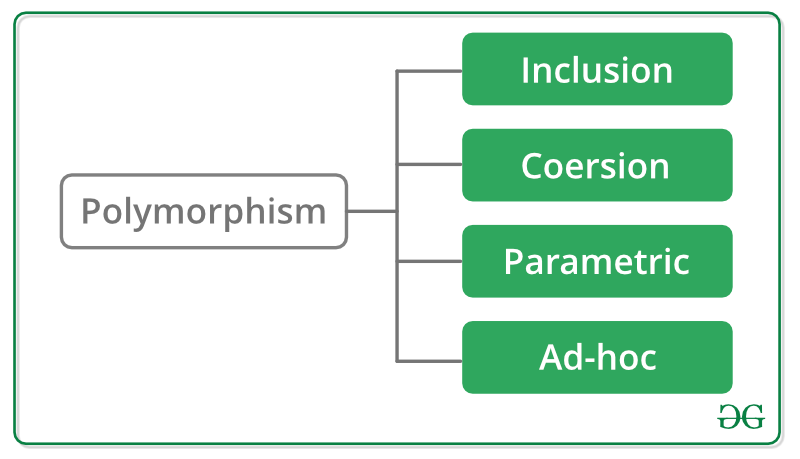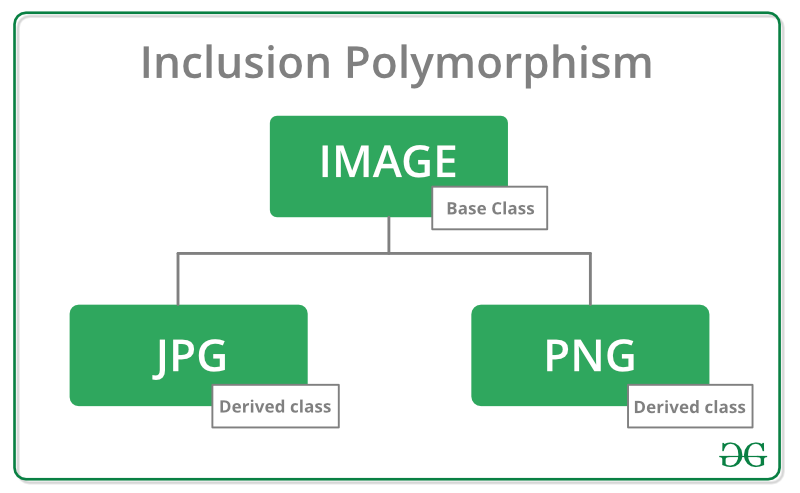Ad-hoc, Inclusion, Parametric & Coercion Polymorphisms
Last Updated :
28 Feb, 2024
When we talk about Polymorphism in C++, we come to hear the following four types:  Discussing these in details:
Discussing these in details:
- Ad-hoc Polymorphism, also called as Overloading Ad-hoc Polymorphism allows functions having same name to act differently for different types. For example: The + operator adds two integers and concatenates two strings.
 Above example could be better illustrated by invoking the function “sum()” in under-mentioned code:
Above example could be better illustrated by invoking the function “sum()” in under-mentioned code:
CPP14
#include <iostream>
using namespace std;
int sum(int x, int y)
{
int c = x + y;
return c;
}
string sum(const char* x, const char* y)
{
string summation(x);
summation += y;
return summation;
}
int main()
{
cout << sum(50, 20)
<< " :- Integer addition Output\n";
cout << sum("Polymorphism", " achieved")
<< " :- String Concatenation Output\n";
}
|
Java
import java.util.*;
public class Main {
public static int sum(int x, int y)
{
int c = x + y;
return c;
}
public static String sum(String x, String y)
{
String summation = x.concat(y);
return summation;
}
public static void main(String[] args)
{
System.out.println(sum(50, 20)
+ " :- Integer addition Output");
System.out.println(
sum("Polymorphism", " achieved")
+ " :- String Concatenation Output");
}
}
|
Python3
def sum(x, y):
c = x + y
return c
def sum_str(x, y):
summation = x + y
return summation
if __name__ == '__main__':
print(f"{sum(50, 20)} :- Integer addition Output")
print(f"{sum_str('Polymorphism', ' achieved')} :- String Concatenation Output")
|
C#
using System;
class Program
{
static int Sum(int x, int y)
{
int c = x + y;
return c;
}
static string SumStr(string x, string y)
{
string summation = x + y;
return summation;
}
static void Main(string[] args)
{
Console.WriteLine($"{Sum(50, 20)} :- Integer addition Output");
Console.WriteLine($"{SumStr("Polymorphism", " achieved")} :- String Concatenation Output");
}
}
|
Javascript
function sum(x, y) {
let c = x + y;
return c;
}
function sumStr(x, y) {
let summation = x + y;
return summation;
}
if (require.main === module) {
console.log(`${sum(50, 20)} :- Integer addition Output`);
console.log(`${sumStr('Polymorphism', ' achieved')} :- String Concatenation Output`);
}
|
Output
70 :- Integer addition Output
Polymorphism achieved :- String Concatenation Output
- Hence, by calling two different functions(which differ in the type of arguments) having the same names, to execute multiple operations, we have successfully achieved Ad-hoc Polymorphism.
- Inclusion Polymorphism, also called as Subtyping Inclusion Polymorphism is the ability to use derived classes through base class pointers and references. It is also known as Run-time polymorphism because the address of the function is not located by the Compiler at compile-time, rather, the right pointer from the virtual table is dereferenced to invoke the function at run-time. The concept of Virtual Function, also known as Dynamic Linkage, is employed to achieve Inclusion Polymorphism. The usage of Virtual Function allows the selection of that function which is to be invoked based on the kind of object for which it is called. For example: To implement such a Polymorphism technique, let us take different files under consideration such as .jpg, .gif, .png files. All these files fall under the category of Image Files.
 So, they can be represented as Classes Derived from Image Base Class and overriding the display() pure virtual function. Above example could be better understood by the following illustration:
So, they can be represented as Classes Derived from Image Base Class and overriding the display() pure virtual function. Above example could be better understood by the following illustration:
CPP14
#include <iostream>
using namespace std;
class Image {
public:
Image()
{
}
virtual void display() = 0;
};
class Jpg : public Image {
public:
Jpg()
{
}
void display()
{
cout << "JPG Image File" << endl;
}
};
class Png : public Image {
public:
Png()
{
}
void display()
{
cout << "PNG Image File" << endl;
}
};
int main()
{
Image* img;
Jpg jg;
Png pg;
img = &jg;
img->display();
img = &pg;
img->display();
return 0;
}
|
Java
abstract class Image {
public Image() {
}
abstract void display();
}
class Jpg extends Image {
public Jpg() {
}
@Override
void display() {
System.out.println("JPG Image File");
}
}
class Png extends Image {
public Png() {
}
@Override
void display() {
System.out.println("PNG Image File");
}
}
public class Main {
public static void main(String[] args) {
Image img;
Jpg jg = new Jpg();
Png pg = new Png();
img = jg;
img.display();
img = pg;
img.display();
}
}
|
Python3
from abc import ABC, abstractmethod
class Image(ABC):
def __init__(self):
pass
@abstractmethod
def display(self):
pass
class Jpg(Image):
def __init__(self):
pass
def display(self):
print("JPG Image File")
class Png(Image):
def __init__(self):
pass
def display(self):
print("PNG Image File")
def main():
img = None
jg = Jpg()
pg = Png()
img = jg
img.display()
img = pg
img.display()
if __name__ == "__main__":
main()
|
C#
using System;
abstract class Image
{
public Image()
{
}
public abstract void Display();
}
class Jpg : Image
{
public Jpg()
{
}
public override void Display()
{
Console.WriteLine("JPG Image File");
}
}
class Png : Image
{
public Png()
{
}
public override void Display()
{
Console.WriteLine("PNG Image File");
}
}
class MainClass
{
public static void Main(string[] args)
{
Image img;
Jpg jg = new Jpg();
Png pg = new Png();
img = jg;
img.Display();
img = pg;
img.Display();
}
}
|
Javascript
class Image {
constructor() {
}
display() {
}
}
class Jpg extends Image {
constructor() {
super();
}
display() {
console.log("JPG Image File");
}
}
class Png extends Image {
constructor() {
super();
}
display() {
console.log("PNG Image File");
}
}
function main() {
let img = null;
const jg = new Jpg();
const pg = new Png();
img = jg;
img.display();
img = pg;
img.display();
}
if (require.main === module) {
main();
}
|
Output
JPG Image File
PNG Image File
- Hence, in the above code, we have two different Classes with a function having the same name and not differing by Parameters, but with different implementations.
- Coercion Polymorphism, also called as Casting Coersion Polymorphism occurs when an object or primitive is cast into some other type. It could be either Implicit or Explicit. Implicit casting happens as a responsibility of Compiler itself. For example: float f=100 (integer implicitly gets promoted to float) Explicit casting makes use of some type-casting expressions such as const_cast, dynamic_cast, etc. For example: When a class defines conversion operator for some type, say “int”, then, it could be employed anywhere in the program where integer type data is expected. Illustration Below could make it more easier to understand:
 This above illustration could be more clarified with help of code below:
This above illustration could be more clarified with help of code below:
CPP14
#include <iostream>
using namespace std;
class IntClass {
int num;
public:
IntClass(int a)
: num(a)
{
}
operator int() const
{
return num;
}
};
void show(int x)
{
cout << x << endl;
}
int main()
{
IntClass i = 100;
show(746);
show(i);
}
|
Java
class IntClass {
private int num;
public IntClass(int a) {
num = a;
}
public int intValue() {
return num;
}
}
class Main {
public static void show(int x) {
System.out.println(x);
}
public static void main(String[] args) {
IntClass i = new IntClass(100);
show(746);
show(i.intValue());
}
}
|
Python3
class IntClass:
def __init__(self, a):
self.num = a
def intValue(self):
return self.num
def show(x):
print(x)
i = IntClass(100)
show(746)
show(i.intValue())
|
C#
using System;
class IntClass {
private int num;
public IntClass(int a) {
num = a;
}
public static implicit operator int(IntClass i) {
return i.num;
}
}
class MainClass {
public static void show(int x) {
Console.WriteLine(x);
}
public static void Main(string[] args) {
IntClass i = new IntClass(100);
show(746);
show(i);
}
}
|
Javascript
class IntClass {
constructor(a) {
this.num = a;
}
intValue() {
return this.num;
}
}
function show(x) {
console.log(x);
}
let i = new IntClass(100);
show(746);
show(i.intValue());
|
- The IntClass reference is used in place of integer type argument, and hence, the concept of Casting is well understood.
- Parametric Polymorphism, also called as Early Binding Parametric Polymorphism opens a way to use the same piece of code for different types. It is implemented by the use of Templates. For example: To develop an understanding of this sort of polymorphism, let us execute a program for finding greater of two Integers or two Strings,
CPP14
#include <iostream>
#include <string>
using namespace std;
template <class temp>
temp greater(temp a, temp b)
{
if (a > b)
return a;
else
return b;
}
int main()
{
cout << ::greater(55, 11) << endl;
string str1("Early"), str2("Binding");
cout << ::greater(str1, str2) << endl;
}
|
Java
public class GreaterDemo {
public static <T extends Comparable<T>> T greater(T a, T b) {
if (a.compareTo(b) > 0) {
return a;
} else {
return b;
}
}
public static void main(String[] args) {
System.out.println(greater(55, 11));
String str1 = "Early";
String str2 = "Binding";
System.out.println(greater(str1, str2));
}
}
|
Python
def greater(a, b):
if a > b:
return a
else:
return b
if __name__ == "__main__":
print(greater(55, 11))
str1 = "Early"
str2 = "Binding"
print(greater(str1, str2))
|
C#
using System;
public class GreaterDemo {
public static T Greater<T>(T a, T b) where T : IComparable<T> {
if (a.CompareTo(b) > 0) {
return a;
} else {
return b;
}
}
public static void Main(string[] args) {
Console.WriteLine(Greater(55, 11));
string str1 = "Early";
string str2 = "Binding";
Console.WriteLine(Greater(str1, str2));
}
}
|
Javascript
function greater(a, b) {
if (a > b) {
return a;
} else {
return b;
}
}
console.log(greater(55, 11));
let str1 = "Early";
let str2 = "Binding";
console.log(greater(str1, str2));
|
- Using Templates, the same function can be parameterized with different types of data, but this needs to be decided at compile-time itself, and hence, this polymorphism is named so. If we wish to achieve such polymorphism for pointers, it turns into Ad-hoc Polymorphism.
Share your thoughts in the comments
Please Login to comment...